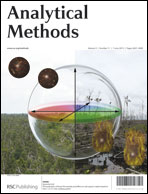Quantum dot immobilized acetylcholinesterase for the determination of organophosphate pesticides using graphene-chitosan nanocomposite modified electrode†
Abstract
We have fabricated a sensitive acetylcholinesterase biosensor that is based on dual-signal amplification. A large amount of enzyme was immobilized on a glassy carbon electrode via specific binding between functionalized ZnSe


 Please wait while we load your content...
Please wait while we load your content...